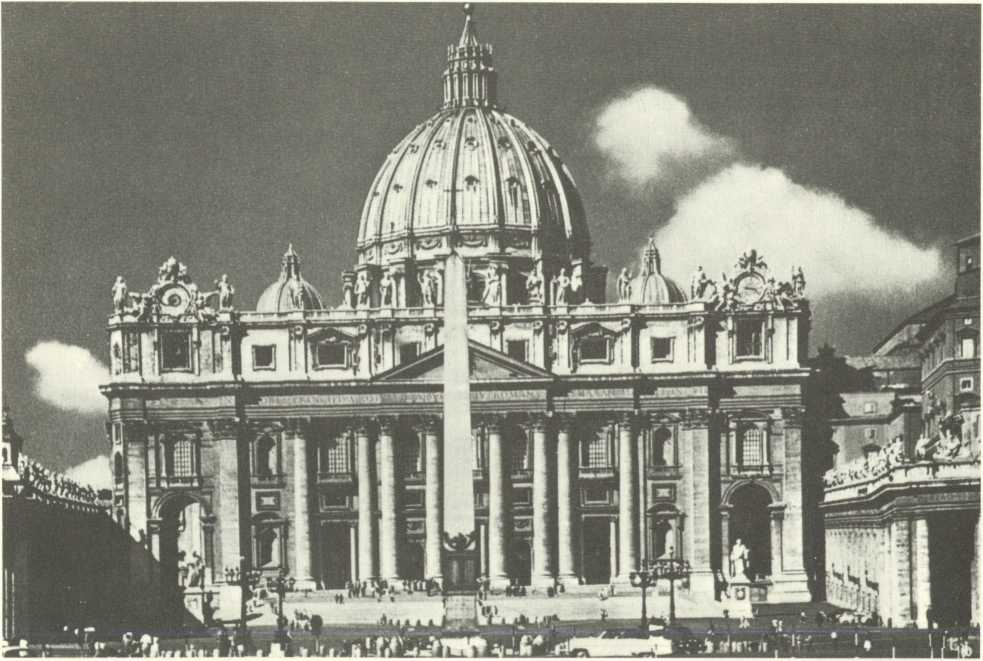Introduction

INTRODUCTION
The Basilica of St. Peter is one of the most important eccle-siastical buildings in the world. It is the focal point of the Vatican City and of paramount importance to Catholics around the world.
Christian churches have long dominated the site upon which St. Peter’s stands today. In a.d. 106, an oratory was constructed on the site to mark the spot where the remains of St. Peter were interred after his crucifixion. In 326, the Emperor Constantine built a basilica on the spot, the facade and interior of which have been recorded by several Italian artists.
The present structure was planned by Alberti and Rossellino during the Pontificate of Nicholas V (1447-55). The project progressed very slowly, and by the time of Julius II’s Pontificate (1503-13), the noted classical architect Bramante had been invited to modify the plans. He gave the building the form of a Greek cross with a hexastyle por-tico and an immense cupola resembling the dome of the Pantheon. Bramante died in 1514, however, and in 1546 the design was left to Michelangelo, who ultimately would execute it after first coming up with a new plan for the church’s dome.
Michelangelo’s appointment followed on the heels of a number of other appointments of architects and was vehe-mently opposed by contemporary artists. Nevertheless, his appointment was confirmed by Julius III in 1552. Michelangelo increased the size of Bramante’s four great pierś and enlarged the tribunes and transepts, largely to ac-commodate his dome. For seventeen years, Michelangelo remained in charge, and by the time of his death at age 88 in 1564, the four great pierś and arches could be seen rising over the walls of the original basilica.
Work came to a virtual halt after Michelangelo’s death and wasn’t resumed until Pope Sixtus V ordered the con-struction to be continued in 1588. Vignola and Pirro Ligorio had been commissioned to execute Michelangelo’s plan by Pius IV; Vignola completed the two smaller cupolas, but did not attempt to complete the dome. In 1583, Giacomo della Porta was given the task of completing the Great Dome by Gregory XIII, who was so obsessed with seeing the comple-tion of the project that he employed 800 workers who la-bored day and night until May 14, 1590, five years after Gregory’s death.
Under subseąuent architects, Michelangelo’s plan was al-tered, until, in 1607, Michelangelo’s Greek cross was aban-doned by architect Carlo Maderno and the present western facade was designed. The nave was finished in 1612 and the facade in 1614. The church was dedicated by Pope Urban VIII in 1626 (however, the Sacristy was not completed until 1780 from designs by Carlo Marchionni). The construction of the Basilica had taken nearly four centuries and had been designed by a hagiology of architects.
The successful completion of the church had a pro-nounced effect on contemporary ecclesiastical architects. The large cupola, especially, found itself duplicated on scores of important church buildings and on hundreds of smaller ones. The delay that marked the construction of St. Peter’s undoubtedly contributed to the rigidity of its classical construction. For a building so innovative, it is, in fact, remarkably conservative in design.
Today, St. Peter’s is the focus of Roman Catholicism. It reflects, in its majesty and grand proportions, the power of the Catholic Church just as much today as it did when it was completed two centuries ago.

(Credit: Istituto Italiano Di Cultura)
Wyszukiwarka
Podobne podstrony:
et al. (1980) for the stability analysis of Palazzo della Ragione, a 13t h Century building in Milan
Design of stubs Practical reasons, will be discussed in lectures, make it morę convenient in many
00214 5151d685820d3809856989a212338cd 216 Baxley Introduction The usual assumption underlying stati
1 Introduction The topie of standardisation and customisation is an interesting issue which mixes th
That is in formal words, but for your information the effect is to introduce the Office of past pres
Fact Sheet S-03 - Means of Public Relation Introduction The main challenge of public relations is to
INTRODUCTION The current issue of “National Security Studies” is smaller in size than previously, si
Easy Tatting (2) Introduction The origin of tatting is somewhat of a mystery. However, it was all th
6 4 the phrase of introducing the theme (get down to business )opening phrase ("joining")
DSCN6669 INTRODUCTION The rich culture and language of Central and Eastem Europę are unique, intrica
więcej podobnych podstron